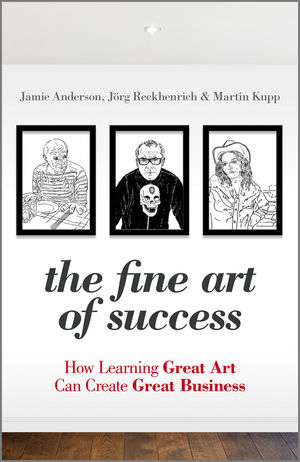Academic articles
Practitioner articles
Working papers
Books
Book chapters
Case studies
Other publications
Subject(s)
Strategy and general management
Keyword(s)
art, management, strategy, innovation, creativity, leadership
You've read about Jack Welch, Lou Gerstner and Steve Jobs - but what can you learn about business from van Gogh and Picasso? The Fine Art of Success shows why you should look to pop-stars like Madonna or artists like Damian Hirst for guidance on innovation, competitive advantage, leadership, and a host of other business issues. Managers, marketing professionals, and students will see how these creative artists can help their organizations. Chapters include Madonna - Strategy at the dance floor; Damian Hirst - The shark is dead/How to build yourself a new market; Beuys - Understanding creativity, is every manager an artist; Picasso - Art lessons for global managers; Koons - Made in Heaven produced on eart; and Paik - Global Groove, innovation through juxtaposition. With controversial ideas, fascinating facts and memorable examples, The Fine Art of Success delivers business lessons that you'll be eager to apply.
Pages
198
ISBN
978–0–470–66106–2
Subject(s)
Strategy and general management
Keyword(s)
growth, innovation, driving change, internationalization, leadership, strategy, China, US, Germany, customization, transfer of brand, merger endgame
The Haier case focuses on how Zhang Ruimin, CEO of the Qingdao Refrigerator Factory, manages to develop a nearly bankrupt factory producing bad quality refrigerators into one of the world's largest white goods producers. With a series of rigorous steps, he: a) manages to improve the quality of the refrigerators produced by putting the right incentives and processes into place; b) expands the product range into other areas of the white goods sector, the after-sales services area as well as into the brown goods and financial services sectors; and c) moves aggressively into foreign markets with inroads made very early on into the largest and most competitive markets of America and Europe.
All of this took place against the backdrop of a China still smarting from the political and economic upheavals of the years and decades before.
The second part of the Haier case (Case B) focuses on the limitations to growth. After Haier achieved outstanding growth, there were a number of cultural and organizational issues to address. Case B should only be used after a discussion of Case A.
| buy now | buy now | buy now |
Subject(s)
Strategy and general management
Keyword(s)
growth, innovation, driving change, internationalization, leadership, strategy, China, US, Germany, customization, transfer of brand, merger endgame
The Haier case focuses on how Zhang Ruimin, CEO of the Qingdao Refrigerator Factory, manages to develop a nearly bankrupt factory producing bad quality refrigerators into one of the world's largest white goods producers. With a series of rigorous steps, he: a) manages to improve the quality of the refrigerators produced by putting the right incentives and processes into place; b) expands the product range into other areas of the white goods sector, the after-sales services area as well as into the brown goods and financial services sectors; and c) moves aggressively into foreign markets with inroads made very early on into the largest and most competitive markets of America and Europe.
All of this took place against the backdrop of a China still smarting from the political and economic upheavals of the years and decades before.
The second part of the Haier case (Case B) focuses on the limitations to growth. After Haier achieved outstanding growth, there were a number of cultural and organizational issues to address. Case B should only be used after a discussion of Case A.
| buy now | buy now | buy now |
Subject(s)
Strategy and general management
Keyword(s)
investment decision, quantitative decision-making, discounted cash flow, net present value, sensitivity analysis, scenario analysis, uncertainty, risk, Monte Carlo simulation, decision trees, spreadsheet modeling, electricity generation, transmission investment, internationalization
The case describes the first quantitative steps in the evaluation of an investment opportunity. It follows the representative of a German utility on his data enquiries about the project of an independent power plant (IPP) in Mexico. The case aims to familiarize students with the most common tools of quantitative decision-making and to make students aware of the advantages and potential pitfalls of these tools. In investments decisions, the use of these techniques can complement a qualitative or strategic choice by providing monetary information related to one or more investment paths. Most importantly, the methods employed in this case allow students to experience different levels of complexity in quantitative analysis, ranging from a standard discounted cash flow analysis to stochastic simulation and decision trees. After having accomplished the case, students will have a basic understanding how to conceptualize strategic investment decisions and implement the appropriate algorithms in spreadsheet modeling.
| buy now |
Subject(s)
Strategy and general management
Keyword(s)
timing of innovation, first mover advantage, program management, business strategy
The case study describes the strategic moves of Airbus in the twin-aisle-twin segment since the announcement by Boeing of the launch of its 787 Dreamliner. Airbus' clients initially reacted negatively to the strategic response on two occasions by criticizing the design of its competitive offering. By the end of 2006, however, there were positive signs that the new design, the A350 XWB, would be able to find its market. However, the formal industrial launch was not yet made and the A350 program management office had been asked to prepare a series of proposals to the Board of EADS regarding the next steps.
| buy now | buy now | buy now |
Subject(s)
Economics, politics and business environment
Keyword(s)
consumer, contracts, regulation, consumer protection
JEL Code(s)
D14, D18, D49, D86
We analyze contract choices, loan-repayment behavior, and welfare in a model of a competitive credit market when borrowers have a taste for immediate gratification. Consistent with many credit cards and subprime mortgages, for most types of nonsophisticated borrowers the baseline repayment terms are cheap, but they are also inefficiently front loaded and delays require paying large penalties. Although credit is for future consumption, nonsophisticated consumers overborrow, pay the penalties, and back load repayment, suffering large welfare losses. Prohibiting large penalties for deferring small amounts of repayment-akin to recent regulations in the US credit-card and mortgage markets-can raise welfare.
Copyright © 2012 by the American Economic Association.
Volume
100
Journal Pages
2279–2303
Subject(s)
Strategy and general management
Keyword(s)
strategy, bottom of the pyramid, CSR, Nigeria, mobile phone
To date, few firms have used a customer-focused approach to serve the world's poorest people - a full two-thirds of the world's total population at the so-called 'bottom of the economic pyramid' (BOP). Much more prevalent has been a mass-produced approach that assumes that the poor in developing economies can only afford basic, cheap products emphasising functionality. In this classic product approach, often little more is done than push existing or barely adapted products onto shantytown dwellers and rural villagers. Consequently, real value that opens up new market spaces for companies and produces longer-term value for the customer has been lost.
Our research reveals that contemporary enterprises that have taken the leap to the customer-focused way of doing business in the developing world grow markets and their stake in them, outperforming traditional enterprise and industry product approaches. The crucial steps in this approach are becoming better known but deserve much more attention.
© 2010 London Business School
Volume
21
Journal Pages
46–51
Subject(s)
Economics, politics and business environment
Keyword(s)
takeovers, merger waves, defense tactics, screening
JEL Code(s)
D21, D80, L11
In our paper, the target of a proposed merger, by setting a reserve price, is able to screen prospective acquirers according to their (expected) ability to generate merger-specific synergies. Both empirical evidence and many merger models suggest that the difference between high and low-synergy mergers becomes smaller during booms. Thus, a target's opportunity cost for sorting out relatively less fitting acquirers increases and, hence, targets screen less tightly during booms, which leads to a hike in merger activity. Our screening mechanism not only predicts that merger activity is intense during booms and subdued during recessions but is also consistent with other stylized facts about takeovers and generates novel testable predictions.
© The Author 2011. Published by Oxford University Press on behalf of The Review of Economic Studies Limited.
Volume
58
Journal Pages
794–817
Subject(s)
Human resources management/organizational behavior
Keyword(s)
initiating change, implementing change, change management, communication of change, lateral change / leading change from the middle, influencing / persuading, stakeholder management, power and politics in organizations, change in a global matrix organization
Anna Frisch has tried to initiate change at Aesch AG, a large global provider of medical devices for the healthcare industry. As marketing director, she has identified major shifts in German healthcare that demand that Aesch changes its ways of approaching customers. Instead of targeting the specific needs of doctors in hospitals, Aesch should rather address the new decision makers: the CEOs, CFOs, or CIOs of hospitals, who have a different buying logic. In Aesch's matrix organization (global product responsibility, supported by regional sales) Anna wants to convince the heads of marketing for the different product businesses to change. She seems to be able to quickly convince her colleagues of what she calls "C-level marketing." However, as soon as work is supposed to start, she realizes that commitments were less strong than she assumed. A few weeks later, Anna is clearly told that there will be no support for her.
The short case study is set when Anna realizes the failure of her change initiative. The case discussion allows analyzing and discussing various mistakes in the areas of:
- defining an attractive vision and strategy,
- reading and playing the organizational culture, power and politics,
- communicating a change initiative successfully,
- managing the stakeholders.
The case is supported by a 6-minute video showing Anna reflecting on the events, her analysis of failure, and her personal preferences as of December 2008.
The short case study is set when Anna realizes the failure of her change initiative. The case discussion allows analyzing and discussing various mistakes in the areas of:
- defining an attractive vision and strategy,
- reading and playing the organizational culture, power and politics,
- communicating a change initiative successfully,
- managing the stakeholders.
The case is supported by a 6-minute video showing Anna reflecting on the events, her analysis of failure, and her personal preferences as of December 2008.
| buy now | buy now | buy now |
Subject(s)
Economics, politics and business environment
Keyword(s)
Reference-dependent utility, gain-loss utility, loss aversion, sticky prices, sales, supermarket pricing
JEL Code(s)
D11, D43, D81, L13
View all ESMT Working Papers in the ESMT Working Paper Series here. ESMT Working Papers are also available via RePEc, EconStor, and the German National Library (DNB).
Pages
66
ISSN (Print)
1866–3494

